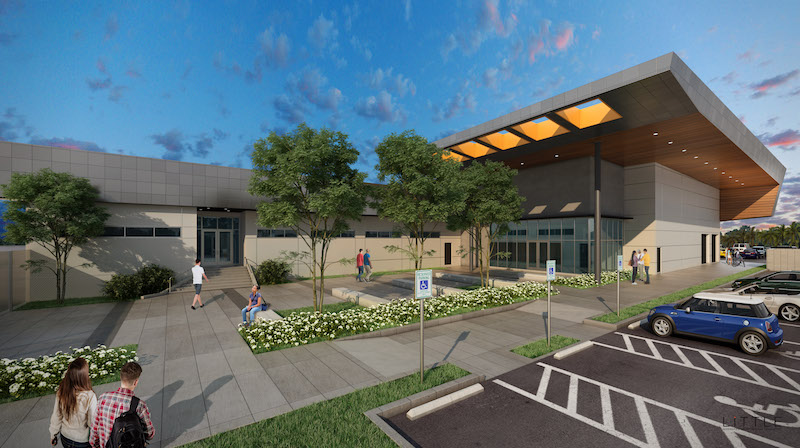On May 13, C.W. Driver, in partnership with Little Diversified Architectural Consulting, broke ground on the Kinesiology and Athletics Complex at Orange Coast College, a $36 million, 88,000-sf building within an Education sector that typically accounts for more than half of this Pasadena, Calif.-based general contractor’s annual revenue.
C.W. Driver, the oldest licensed builder headquartered in Southern California, is celebrating its 100th anniversary this year, and is showing little sign of slowing down. The company, with seven offices and 365 employees across California, generates between $700 million and $850 million per year in revenue.
In a consolidating industry where firms are frenetically acquiring new practices and disciplines to stay competitive, C.W. Driver remains an anomaly: a GC that builds almost exclusively in one state. Its portfolio includes academic, entertainment and sports, retail, civic and cultural, office, commercial hospitality and gaming, healthcare, residential and senior living.
“It’s not that we haven’t tried in the past” to diversify, says Karl Kreutziger, the firm’s president, who spoke with BD+C last week. At one time, C.W. Driver was self-performing concrete and drywall. It also once had an international business in Singapore.
Kreutziger, who has been with the firm since 2011, attributes its longevity to sticking with its core competencies and focusing the bulk of its work in the Greater Los Angeles market. (Eighty percent of its revenue comes from repeat customers.)
The company also has management continuity, starting with its CEO Dana Roberts, who has been with C.W. Driver for 48 years. In the 1990s, Roberts brought in two partners: CFO Bessie Kouvara, who retired in 2017; and Executive Vice President John Janacek, who oversees estimating.

Karl Kreutziger, C.W.Driver's president since 2011, attributes his company's longevity, in part, to its careful selection of projects. Image: C.W. Driver
The company was founded in 1919 by John McDonald and Clarence Wike Driver, the latter of whom had been working for one of the oldest architectural firms in L.A. During its first decade in business, C.W. Driver worked mostly on smaller projects. Driver’s son, Douglas, led the company through its next era and was active until 1987, when he turned over the reins to Roberts.
At a time when recruiting and retaining talent are challenges for many AEC firms, C.W. Driver has been able to hold onto its employees in part by offering some of them ownership in the company. It currently has 25 owners. And over the past two years, says Kreutziger, “we’ve had some ‘boomerangs,’ people who had left the company and have returned.” The fact that it offers full health insurance to all of its employees doesn’t hurt, either.
Like other GCs, C.W. Driver must deal with labor shortages. Keeping its trades on board, says Kreutziger, starts with a focused business development strategy “that identifies the projects we can be successful doing.” That requires early involvement at the preconstruction level, and then “committing to our key trade partners,” he says.
To avoid commoditizing its services, C.W. Driver steers away from design-bid-build projects, which account for less than 2% of its annual revenue. And while it has done work in Nevada, C.W. Driver usually passes on projects outside of its primary markets because, explains Kreutziger, “we just can’t get the [subs] to go there.”
As it moves into its second century, C.W. Driver wants to continue to grow organically. Kreutziger says the firm has been spending more time lately on succession planning and employee training. It also wants to make sure it is ahead of emerging markets like modular and panelized construction.
The firm is open, albeit cautiously, to new ventures that include acquisition. In August 2013, C.W. Driver acquired Good & Roberts, a 34-year-old San Diego-based construction company, which helped to bolster a market where C.W. Driver had been growing since 2006.
C.W. Driver also operates Driver SPG, an internal group it formed in 2011 that specializes in tenant improvement projects ranging from $500,000 to $15 million. Driver SPG represents about $80 million of C.W. Driver’s annual revenue, and “there’s a lot of crossover clients,” says Kreutziger.

C.W. Driver is the oldest liscensed builder headquartered in Southern California, a state where the GC continues to do most of its work. Image: C.W. Driver
Related Stories
Museums | Aug 29, 2024
Bjarke Ingels' Suzhou Museum of Contemporary Art conceived as village of 12 pavilions
The 60,000-sm Suzhou Museum of Contemporary Art in Suzhou, Jiangsu, China recently topped out. Designed by Bjarke Ingels Group (BIG), the museum is conceived as a village of 12 pavilions, offering a modern interpretation of the elements that have defined the city’s urbanism, architecture, and landscape for centuries.
Adaptive Reuse | Aug 28, 2024
Cities in Washington State will offer tax breaks for office-to-residential conversions
A law passed earlier this year by the Washington State Legislature allows developers to defer sales and use taxes if they convert existing structures, including office buildings, into affordable housing.
Industrial Facilities | Aug 28, 2024
UK-based tire company plans to build the first carbon-neutral tire factory in the U.S.
ENSO, a U.K.-based company that makes tires for electric vehicles, has announced plans to build the first carbon-neutral tire factory in the U.S. The $500 million ENSO technology campus will be powered entirely by renewable energy. The first-of-its-kind tire factory aims to be carbon neutral without purchased offsets, using carbon-neutral raw materials and building materials.
Building Technology | Aug 23, 2024
Top-down construction: Streamlining the building process | BD+C
Learn why top-down construction is becoming popular again for urban projects and how it can benefit your construction process in this comprehensive blog.
Airports | Aug 22, 2024
Portland opens $2 billion mass timber expansion and renovation to its international airport
This month, the Portland International Airport (PDX) main terminal expansion opened to passengers. Designed by ZGF for the Port of Portland, the 1 million-sf project doubles the capacity of PDX and enables the airport to welcome 35 million passengers per year by 2045.
Adaptive Reuse | Aug 22, 2024
6 key fire and life safety considerations for office-to-residential conversions
Office-to-residential conversions may be fraught with fire and life safety challenges, from egress requirements to fire protection system gaps. Here are six important considerations to consider.
Contractors | Aug 22, 2024
Growing a $250 million business by focusing on preconstruction, with Wes Palmisano
One of the most critical aspects of successfully growing a construction company is the often-overlooked preconstruction phase.
Resiliency | Aug 22, 2024
Austin area evacuation center will double as events venue
A new 45,000 sf FEMA-operated evacuation shelter in the Greater Austin metropolitan area will begin construction this fall. The center will be available to house people in the event of a disaster such as a major hurricane and double as an events venue when not needed for emergency shelter.
Contractors | Aug 22, 2024
Why all construction business problems are people problems, with Eric Anderton
In the chaotic construction world where systematization is not a norm, it’s safe to say that people’s problems remain the biggest main challenge.
Contractors | Aug 21, 2024
The average U.S. contractor has 8.4 months worth of construction work in the pipeline, as of July 2024
Associated Builders and Contractors reported today that its Construction Backlog Indicator held steady at 8.4 months in July, according to an ABC member survey conducted July 22 to Aug. 6. The reading is down 0.9 months from July 2023.

















